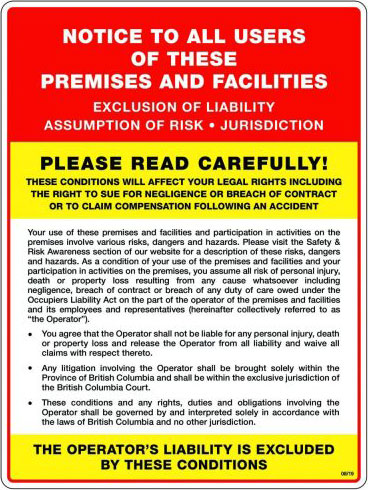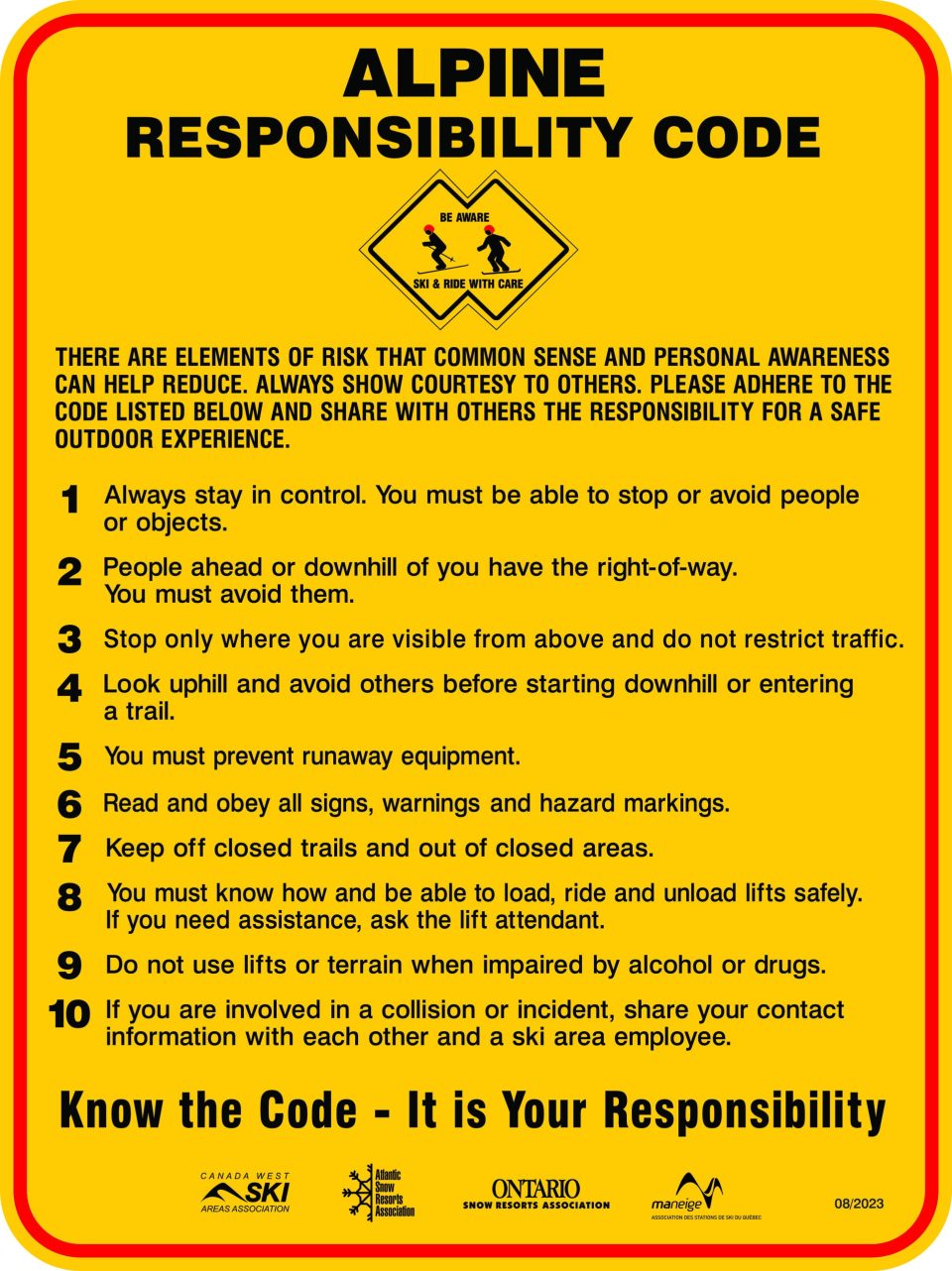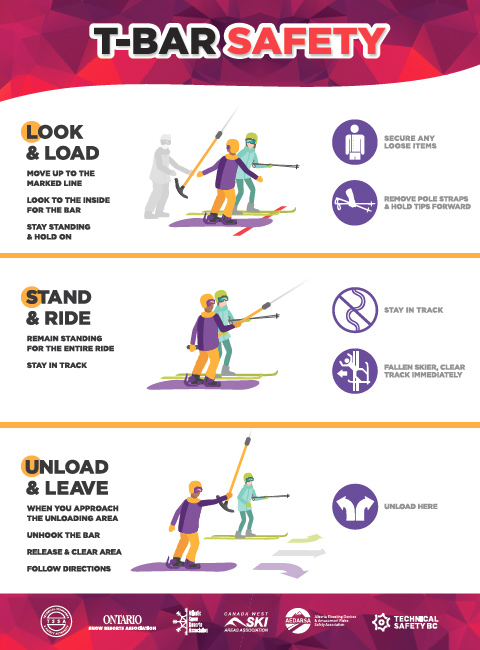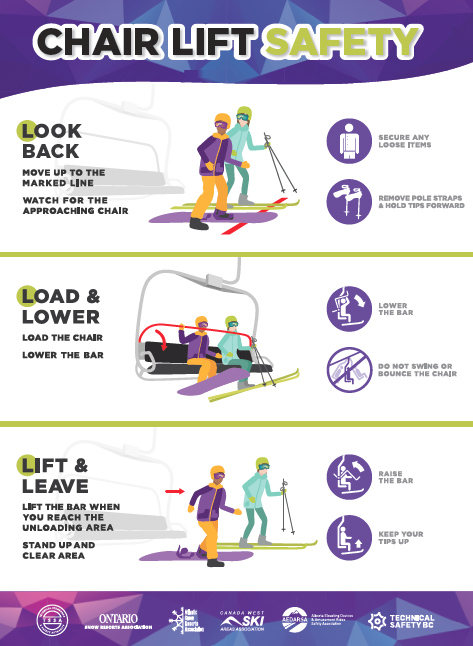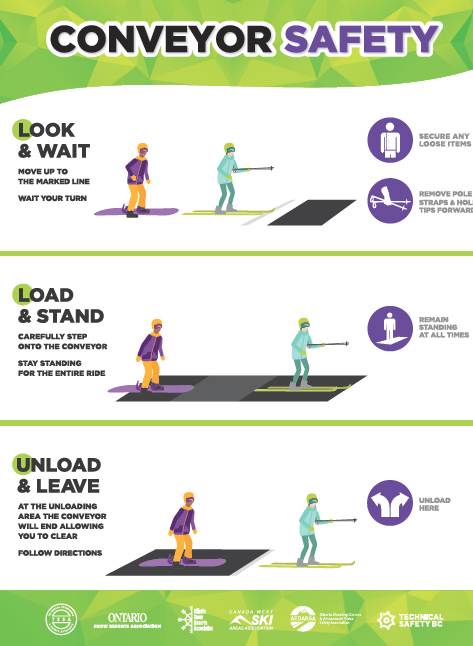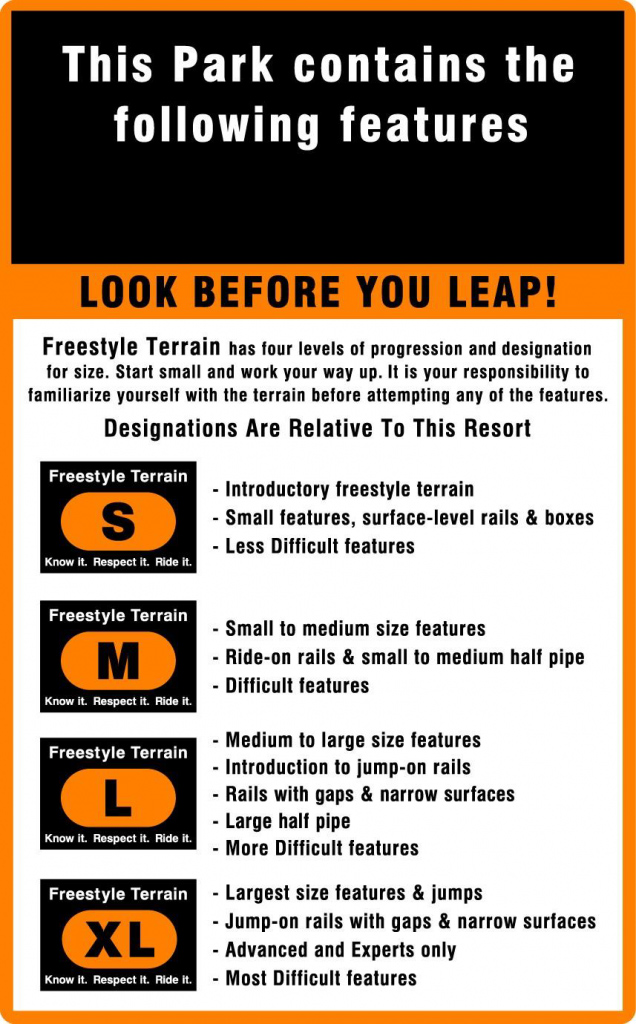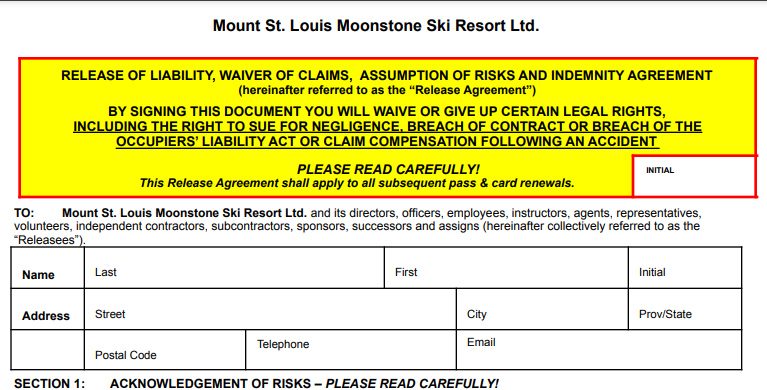Skiing, snowboarding and other activities that take place at ski areas involve the risk of injury. The information contained in the Safety and Risk Awareness section of this website is intended to inform you of the risks, dangers and hazards that you may encounter at a ski area and help you to stay safe while enjoying these activities. Whether you are a participant in these activities or a parent or guardian of a minor participant, please take the time to familiarize yourself with the Safety and Risk Awareness information on this website.
Safety & Risk Awareness
Exclusion Of Liability – Assumption of Risks
The use of ski area premises and facilities and participation in activities at ski areas involves various risks, dangers and hazards. It is a condition of your use of the premises and facilities and your participation in these activities that you assume all risk of personal injury, death or property loss resulting from any cause whatsoever, including negligence, breach of contract, or breach of any duty of care on the part of the ski area operator. Your legal responsibility as a user of the ski area premises and facilities or participant in activities at the ski area is explained in the following notice, which you will see posted at the ski area.
Skiing and Snowboarding
Skiing, and snowboarding, involves various risks, dangers and hazards including, but not limited to the following:
- boarding, riding and disembarking ski lifts;
- changing weather conditions;
- avalanches;
- exposed rock, earth, ice, and other natural objects;
- trees, tree wells, tree stumps and forest deadfall;
- the condition of snow or ice on or beneath the surface;
- variations in the terrain which may create blind spots or areas of reduced visibility;
- variations in the surface or sub-surface, including changes due to man-made or artificial snow;
- variable and difficult conditions;
- streams, creeks, and exposed holes in the snow pack above streams or creeks;
- cliffs; crevasses;
- snowcat roads, road-banks or cut-banks;
- collision with lift towers, fences, snow making equipment, snow grooming equipment, snowcats, snowmobiles or other vehicles, equipment or structures;
- encounters with domestic and wild animals including dogs and bears;
- collision with other persons;
- loss of balance or control; slips, trips and falls;
- accidents during snow school lessons;
- negligent first aid;
- failure to act safely or within one’s own ability or to stay within designated areas;
- negligence of other persons;
- and NEGLIGENCE ON THE PART OF THE OPERATOR and its directors, officers, employees, instructors, agents, representatives, volunteers, independent contractors, subcontractors, sponsors, successors and assigns.
Alpine Ski/Snowboard Boot Binding Systems
Alpine Ski/Snowboard Boot Binding Systems
The ski boot/binding system for alpine skiing may not release during every fall or may release unexpectedly. The ski boot/binding system is no guarantee that the skier will not be injured.
The snowboard boot/binding system is not designed or intended to release and will not release under normal circumstances. Given the snowboard boot binding system is a non-system, the system will not reduce the risk of injury during a fall and will increase the risk of not surviving an avalanche.
Helmets
A helmet designed for recreational snow sports may reduce the risk of some types of head injuries. Helmets are strongly recommended. In some ski area programs (for example snow school lessons involving minors) helmets are mandatory. Helmets for skiing and snowboarding are light, comfortable and have achieved wide-spread acceptance. Please note however that helmets have limitations and that serious head injury can still occur even when a helmet is worn. Wearing a helmet is no guarantee of safety.
Alpine Responsibility Code
The Alpine Responsibility Code provides the basic rules of conduct and must be followed by all using the terrain, and is consistent across all Ski Areas of Western Canada.
- Always stay in control. You must be able to stop, or avoid other people or objects.
- People ahead of you have the right-of-way. It is your responsibility to avoid them.
- Do not stop where you obstruct a trail, or are not visible from above.
- Before starting downhill or merging onto a trail, look uphill and yield to others.
- If you are involved in or witness a collision/accident you must remain at the scene and identify yourself to the Ski Patrol.
- Always use proper devices to help prevent runaway equipment.
- Observe and obey all posted signs and warnings.
- Keep off closed trails and obey area closures.
- You must not use lifts or terrain if your ability is impaired through the use of alcohol or drugs.
- You must have sufficient physical dexterity, ability, and knowledge to safely load, ride, and unload lifts. If in doubt, ask the lift attendant.
Learn more about the Alpine Responsibility Code in this Video.
Lift Safety
To travel uphill at Ski Areas, skiers and snowboarders use a variety of ski lifts. Users should be familiar with the use of lifts for their own safety and the safety of others.
There are many signs on and around ski lifts. Each is important in its own right, informing you about the process for loading, riding, and unloading the chair. Pay attention to and obey these signs when riding a chairlift. If you are unfamiliar with a lift or have questions, please ask a lift attendant for assistance and directions. Ski and snowboard lessons are also great ways to learn about using the ski lifts.
Important! Alpine Responsibility Code #9 states “You must not use lifts or terrain if your ability is impaired through the use of alcohol or drugs.”
Here are a few tips for riding ski lifts
Get prepared and be ready!
- If unfamiliar with a lifts operation, first watch others and learn, or ask for assistance.
- Slow down before approaching the entrance to a lift.
- Obey all posted instructions.
- Ensure your lift ticket is available for ticket checkers. For RFID enabled tickets ensure your ticket is in a pocket without other cards or electronics, so it can be read by the RFID gates.
- Remove pole straps from wrists, hold poles with tips forward.
- Secure loose items – make sure you don’t have anything that can catch on the carrier (chair, tbar, conveyor etc) like loose clothing, zippers, strings and hair.
- Remove audio headsets before reaching the lift-loading and unloading platform.
- If carrying a backpack, remove it and hold on your lap while on the lift. Infant front carriers and child backpack carriers are not permitted on ski lifts (with the exception of some gondolas that also provide sightseeing).
- To speed up everyone’s ride, group up before reaching the final cue.
- When riding a lift with small children, help them load and unload as well as lower and raise the bar.
- It is OK to miss a chair and wait for the next one.
Remember the Alpine Responsibility Code #10. “You must have sufficient physical dexterity, ability, and knowledge to safely load, ride, and unload lifts. If in doubt, ask the lift attendant.”
Loading the lift
- Load and unload only at designated areas.
- Be polite and courteous at the loading area.
- In preparation to load, move up to the marked line and look back to watch for the approaching chair.
- Grab onto the side or back of the chair and scooch yourself towards the back. If you’re skiing with kids, you may need to help pull them up onto the chair.
- Always lower the restraining bar immediately after loading the chair. Let the other riders on the chair know that you’re lowering the bar to avoid any head collisions.
- Swinging, bouncing or otherwise abusing lift equipment can be dangerous. If alone, sit in the middle of the chair.
- If lift stops, never attempt to jump off.
Unloading
- Make certain no loose clothing is caught in the lift before unloading.
- Lift the bar when you reach the unloading area (always wait to see the “Raise the bar” sign).
- Keep your tips up and when you reach the “Unload Here” sign, stand up and slide down the ramp.
- Move quickly away from the unloading area. If you happen to fall or leave something behind, keep your head down (to avoid getting hit by the carrier) and clear out of the way as soon as you are able. The lift operators are able to assist you.
Surface lifts such as tbars, platters, conveyors and rope tows follow many of the same guidelines as above. Also note:
- Stay standing for the entire ride. Never sit down.
- Only unload in the designated unloading area – do not get off the lift prior to the “Unload Here” sign.
- If you fall, clear the track quickly.
Lift Safety Posters
Click image to enlarge
Know before you go!
In addition to the Alpine Responsibility Code, here are some additional tips to keep you safe and enjoy your day on the slopes:
- Weather
- Plan ahead for variations in weather. Dress appropriately, and have properly tuned gear. Warmth and visibility are key safety components.
- UV rays are reflected from the snow surface. Always wear sunscreen, and goggles or sunglasses, even on cloudy days.
- Cold temperatures increase the likelihood of frostbite. Dress warm, bring extra layers and keep an eye on exposed skin. Go inside immediately if skin begins to turn white.
- Take note of the conditions. When the snow surface is hard and fast, it is easy to ski/ride at high speed, increasing the risk for serious injury if you fall and slide. Be aware of changing snow surface conditions.
- Keep hydrated and carry a snack with you to keep you fueled.
- Ski with a buddy.
- Identify meeting points with your group in case you become separated. All group members should know where to meet should separation occur.
- Carry a whistle and be particularly cautious when skiing/riding in the trees. Tree wells are a real risk. See more on Tree Well Safety.
- Helmets – it is highly recommended to wear a helmet while skiing and riding. Skiers and snowboarders are encouraged to educate themselves on the benefits and limitations of helmet usage. See more on snow sports helmets.
- Don’t over do it. Be aware of fatigue, many visitors are on vacation and might not be conditioned to ski/board long days. Warm up in the morning and stretch it out, then tone it down in the afternoon.
- Snowcats and snowmobiles may be encountered during operating hours. Give these vehicles plenty of space.
- Be aware of your surroundings.
- Be mindful of where you stop on the hill, for your safety and the safety of other skiers and snowboarders. When resting, move over to the side of the run. Never stop under a roller, jump, cat track, or on a blind corner, as uphill skiers will not be able to see you.
- Always be aware of other skiers and snowboarders. Look uphill before you commence downhill, and yield to other skiers and snowboarders.
Check out these great videos to learn about safety, preparation and helmets
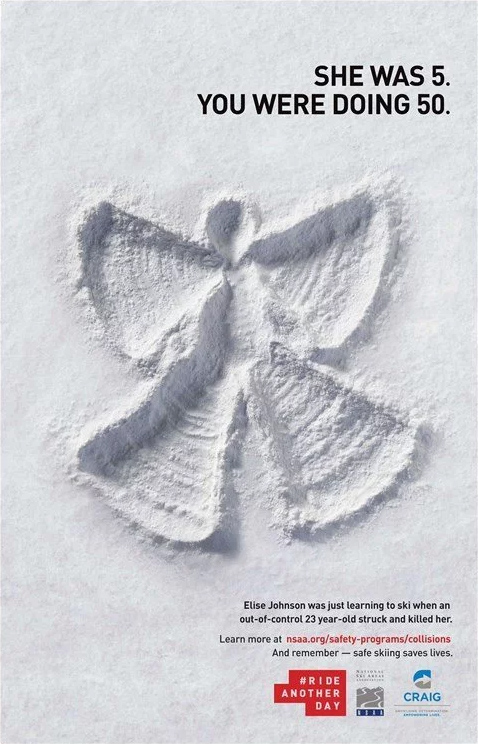
Speed and Collision Safety
Ride Another Day
Complementing the Responsibility Code, #RideAnotherDay promotes three actions every skier and rider can take to help keep themselves and those around safer on the slopes. These three actions are:
Be Ready – Be ready to slow down or avoid objects or other people at any time. Ski and ride in such a way that you are always able to control yourself regardless of conditions and avoid others and objects you may encounter on the run, groomed or otherwise.
Stay Alert – Stay alert to what’s going on around you, especially other skiers and riders. Being aware of those around and changing conditions will help you have a fun and safe day on the hill.
Plan Ahead – Ease up at blind spots, check uphill when merging onto trails, and give other skiers plenty of room when passing. Look out for spots on the run where traffic merges or you can’t see what’s coming next. If you are unfamiliar with a run, take it easy the first time down it and make note of places where you’ll want to slow down, such as cat tracks and rollers. Also, give other skiers and riders lots or room, especially if you are passing them. There’s plenty of space out there, so there’s no need to crowd each other.
By doing these three things every run, you’ll be helping keep the slopes safe and enjoyable, for you and everyone else.
View this moving video about the impact speed had on the Johnson Family.
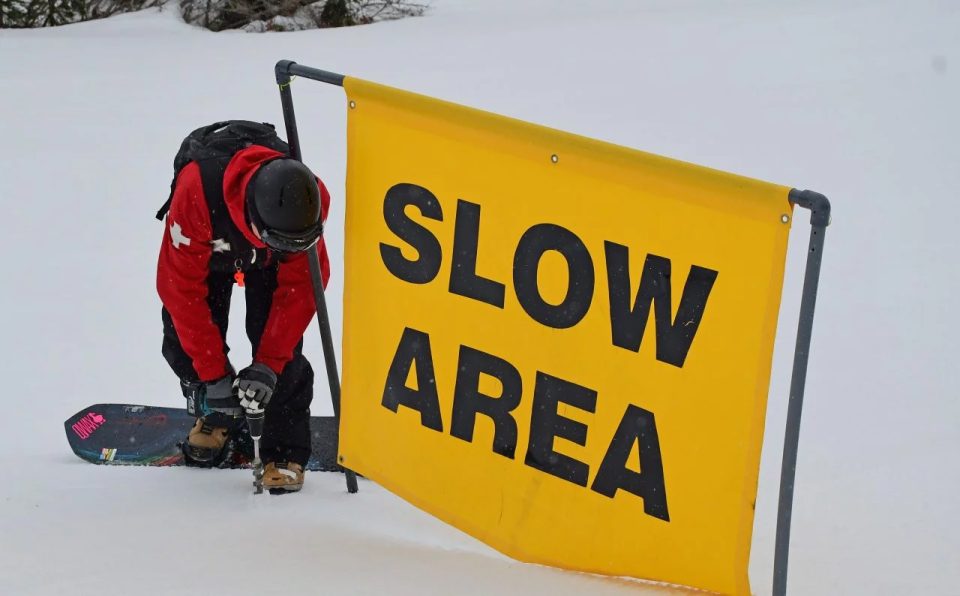
Slow Zone
Slow Zone banners and signs mark an area or areas of the ski hill where trails converge, base areas and where skiing fast poses a risk of injury or collision. Green runs are also generally considered to be slow zones. Please approach these areas slowly and with extreme caution. Not only is there higher traffic volumes in these areas, but they are often frequented by young children, beginners and seniors. Jumps and hits are not allowed in Slow Zones.
One of the biggest users of Green runs and Slow Zones are children. Children don’t have a high awareness of what other people are doing and are easily distracted. They might be on one side of the run and quickly without warning veer over and cross the run without checking to see if anyone is coming. Kids and adults that are learning to ski also tend to fall on terrain transitions (knolls) and can be trying to recover from a crash in an area that can’t be seen from above.
Failure to ski slowly and in control in the slow zones may result in lift privileges being revoked.
How fast is too fast?
Many people have a hard time remembering what it was like to be a beginner skier or snowboarder, and having to worry about whether there is enough space to attempt a turn. So first off, think about giving people some space. Next, remember that you must always be in control whether you are on an expert run or in a Slow Zone. This is the first point of the Alpine Responsibility Code. If you are in the air, you have no control over your speed or direction. The speed expected is relevant to how many people are on the run. When there are more people on the run the 10% Rule is in effect. You may pass people at a speed approximately 10% faster than the flow of other skier traffic on the run.
Ski Area Premises
When visiting a ski area, the premise is not limited to the ski runs – many ski areas will have day lodges, parking lots, restaurants, tube/tobogganing areas, terrain parks, walkways, access roads and other ski area facilities. You will come across signage throughout the ski area premise that are important to respect and understand. Please pay close attention to all signage. It is present for the safety of both guests and employees. Failing to follow the directions on these signs may result in the loss of your ticket or pass. It is your responsibility to be aware of mountain signage at all times.
Ski Area Boundary
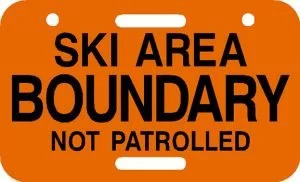
Most ski areas mark their operational boundaries with fencing or signage.
The terrain within the ski area boundary is patrolled by the ski patrol and some hazards are marked. The area beyond the ski area boundary is neither controlled nor patrolled by the ski patrol. Some ski areas permit skiers and snowboarders to travel beyond the ski area boundary into the backcountry. Backcountry travel can be very hazardous and requires specialized equipment, training and experience. Do not travel into the backcountry if you are not qualified to do so. Some ski areas may close their ski area boundaries or portions of the boundary. A closure sign must be respected and obeyed. Breach of a closure could result in the loss of ski area privileges and other sanctions.
Closed Runs
Skiing and snowboarding in closed runs and areas is strictly prohibited. Runs are closed for several reasons: trees have fallen onto the run, ditches or holes have rendered the run unsafe, a race or other events are taking place, Terrain Parks are not yet ready to open, or perhaps machinery is operating. Observe and obey all posted signs and warnings. Ignoring these messages may put you at greater risk. Those who violate closures may lose lift privileges.
Marking, Flagging, Fencing
There are a number of different signs and markers to indicate conditions, boundaries and warnings on the Ski Area Premise.
All poles, flags, fencing, signage and padding on equipment or objects or other forms of marking devices are used by the ski area to inform you of the presence or location of a potential obstacle or hazard. These markers are no guarantee of your safety and will not protect you from injury. It is part of your responsibility under the Alpine Responsibility Code to avoid all obstacles or hazards, including those that are so marked. Inbound terrain includes natural hazards including cliffs and cornices. Ski with caution, unmarked objects and hazards may exist.
Relative trail difficulty
The designation of run difficulty is set by each ski area individually. Skiers and riders should be advised that a Green Circle, Blue Square or Black Diamond trails are not necessarily the same as a similarly rated trail at another area. Skiers and riders should work their way up, beginning with the easiest trails, no matter what their ability level may be, until they are familiar with the trails at each ski area.
Walking in ski area
Walking in ski areas should not be overlooked as a risk, with potential for serious injuries. There are many wet, icy, slippery surfaces through the ski area premise. Slips, trips and falls are common and all users should take precautions at all times when travelling throughout a ski area. Ski boots and many types of other footwear do not provide good traction, and extra caution should be used when walking.
Using Terrain Parks
Be Park Smart
When riding in Terrain Parks, there are a number of specific etiquette and safety practices that all users should follow.
The basics of terrain park safety are outlined in the Smart Style – Park Smart Terrain Safety Program.
- START SMALL. Work your way up. Build your skills.
- MAKE A PLAN. Every feature. Every time.
- ALWAYS LOOK before you drop.
- RESPECT the features and others.
- TAKE IT EASY. Know your limits. Land on your feet.
Before you drop in
- Read the entrance signs – each entrance is marked with a unique sign stating park terrain difficulty levels. Please follow within your ability and always be in control.
- Take a warm up run – it is recommended that you take a ride through the park and check it out so you can get a visual of what to expect and the confidence to succeed.
- Progression – to progress through jumps and features gradually increase the challenge and difficulty. Don’t attempt maneuvers that are beyond your ability.
- Start small – if you’re new to riding terrain parks, we recommend that you start small with beginner features and get the basics down and work your way up. If you are having trouble, take a lesson.
- Helmets are highly recommended.
Closed means closed – know when to avoid terrain and features
- If you see a rope line, fencing, signs or bamboo across a takeoff it is up for a reason. Please do not remove and do not ride those features. If you have any questions or concerns find one of the Park staff.
- Let the Park staff do their job – if you see Park staff working on a feature, please skip that feature and come back when they are done.
- If there are boards or skis in front of a jump, the jump is closed so go around the feature.
Practice Park Etiquette
- Don’t stop or sit on landings and knuckles – if you need to stop and take a break for a moment do not sit where people cannot see you.
- Keep landings clear – never stop to take a break in a landing, bottom of roller or anywhere that you are not visible to riders uphill from you. Clear the landing area to avoid collisions.
- Do not ride through landings. When not using features, stay off to the side of the trail, out of the way.
- Use features in the manner in which they are intended. Don’t jump off the sides of the takeoffs. Save the takeoff lips for the people who want to ride the feature correctly. Practice riding on small jumps or rollers instead.
- Do not snake – be courteous of your fellow park riders, call your drops and give people a decent amount of time and space when waiting to ride a feature to avoid cutting people off.
- Slow down when exiting the terrain park.

